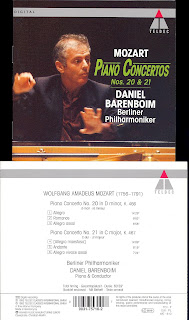This disc resides at number 7 in my all time favourite list, out of 1600 odd discs i own that's high!, i've played this countless times, and each time i've marvelled at the playing of Itzhak Perlman, in his heyday he could play the violin so effortlessly, even under extreme pressure of complex / virtuosic scores, and do it with such panache and insouciance, for an idea of what i mean, just listen if you can to the closing pages of Sarasate's Carmen Fantasy, the screws of difficulty tighten and tighten, but Perlman takes it in his stride, almost laughing it off, turn to Anne-Sophie Mutter and you can feel the pressure and the grimace as she tries to hold it together.
Itzhak Perlman is an Israeli Violinist, born in 1945, making him 65 today, he recorded this disc in 1986.
Well on this listen i have to admit that it was the closing work on this disc that made my heart jump, the Introduction And Rondo Capriccioso from Saint-Saens, is a 9 minute extravaganza, but full of poetry too, i must admit there doesn't seem a lot of structure to the piece, it meanders all over the place, more like a Fantasy than a Rondo, the Introduction [0:00-1:38] lasts roughly 20% of the piece, a more quiet and sad refrain, but at the changeover into the Rondo Capriccioso there's an orchestral / timpani 'jump', and then the fun starts!, like the strike of midnight and all the colourful characters and magic begin, some of the highlights are as follows,
2:22 - Perlman plays some high trills and a few screeching notes, very effective.
2:43 - and very short quick notes and trills, nicely up and down the violin.
5:20 - and high notes, up very high in the violin tessitura, extremely short and fast too, but quickly coming down to the bass, a lovely shot of virtuosity!.
7:02 - again another set of high wire trills, one after another.
7:23 - 8:01 - then comes for me the highlight of the piece, all sorts of effects are displayed by the Fiddler, but it's the violin that chugs along on it's trapeze act, while an oboe appears [7:40], and plays the sad melody, while the oblivious violin keeps going.
8:18 - and of course there's a finale, where the violin just can't resist showing off in a lovely ending.
1:50, 3:13 & 5:34 - right after each of the three 'jumps', the violin plays a lovely gypsy / fiddle figure, each time i hear it i marvel at Perlman's virtuosity.
2:43 - and very short quick notes and trills, nicely up and down the violin.
5:20 - and high notes, up very high in the violin tessitura, extremely short and fast too, but quickly coming down to the bass, a lovely shot of virtuosity!.
7:02 - again another set of high wire trills, one after another.
7:23 - 8:01 - then comes for me the highlight of the piece, all sorts of effects are displayed by the Fiddler, but it's the violin that chugs along on it's trapeze act, while an oboe appears [7:40], and plays the sad melody, while the oblivious violin keeps going.
8:18 - and of course there's a finale, where the violin just can't resist showing off in a lovely ending.
Here's Perlman playing Saint-Saens Introduction And Rondo Capriccioso on YouTube.










